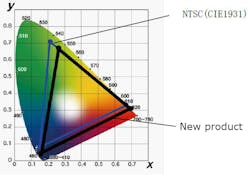Osaka, Japan--As described at Tech-On!, Sharp Corporation has developed a white-light LED intended for screen backlighting that has a 90% color gamut (meaning a purer white light) than conventional blue-LED/yellow-phosphor white-light sources. This color gamut is 25% higher than for conventional LEDs.
Sharp's LED combined a blue emitter with red and green phosphors. The most important point: Sharp's new LED reduces screen brightness by only 3% compared to conventional LEDs, which means that it is highly efficient. This is in contrast to a previous similar approach that reduced screen brightness by 20%.
The new LED can be swapped in to replace conventional LEDs without making any changes to the liquid crystal display (LCD) cells.
Sharp developed four models of the device: two for small and middle-sized LCD panels (0.4 and 0.6 mm in thickness) and two for large-sized panels (edge- and direct-type backlights). The price of their samples is ¥40 (approx US $0.39, including tax). Sharp plans to release the samples Dec 24, 2013, and start volume production in April 2014.
Commenting on the reason why it became possible to realize a brightness higher than that of the existing wide color gamut LCD panels, Sharp said, "It is because we have developed the red and green phosphors that use totally new materials and have high conversion efficiencies (in regard to the light that comes from a blue LED chip and hits a phosphor, resulting in wavelength conversion)."
A phosphor maker developed the red phosphor for Sharp, while the green phosphor was co-developed by Sharp and a phosphor maker.
In addition to the high conversion efficiency, the new device increases the peak intensity of the spectrum of red light and decreases its peak width, realizing a spectral distribution in which the peaks of red and green lights do not overlap much.
Source: http://techon.nikkeibp.co.jp/english/NEWS_EN/20131217/323134/

